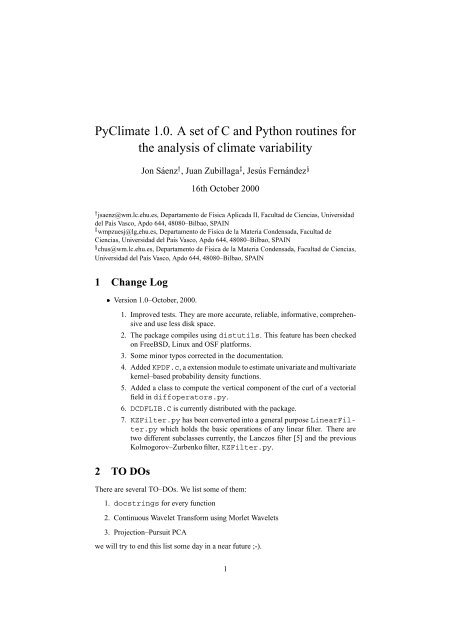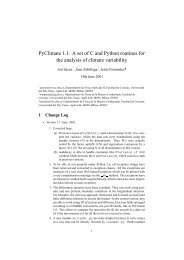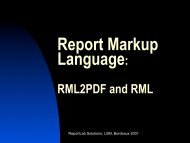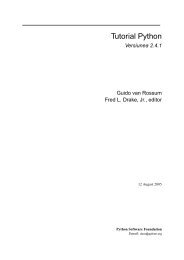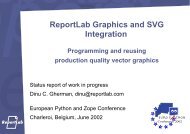PyClimate 1.0. A set of C and Python routines for the ... - Starship
PyClimate 1.0. A set of C and Python routines for the ... - Starship
PyClimate 1.0. A set of C and Python routines for the ... - Starship
You also want an ePaper? Increase the reach of your titles
YUMPU automatically turns print PDFs into web optimized ePapers that Google loves.
£¤¥Jon Sáenz , Juan Zubillaga ¡ , Jesús Fernández ¢<strong>PyClimate</strong> <strong>1.0.</strong> A <strong>set</strong> <strong>of</strong> C <strong>and</strong> <strong>Python</strong> <strong>routines</strong> <strong>for</strong><strong>the</strong> analysis <strong>of</strong> climate variability16th October 2000jsaenz@wm.lc.ehu.es, Departamento de Física Aplicada II, Facultad de Ciencias, Universidaddel País Vasco, Apdo 644, 48080–Bilbao, SPAINwmpzuesj@lg,ehu.es, Departamento de Física de la Materia Condensada, Facultad deCiencias, Universidad del País Vasco, Apdo 644, 48080–Bilbao, SPAINchus@wm.lc.ehu.es, Departamento de Física de la Materia Condensada, Facultad de Ciencias,Universidad del País Vasco, Apdo 644, 48080–Bilbao, SPAIN1 Change LogVersion 1.0–October, 2000.¦1. Improved tests. They are more accurate, reliable, in<strong>for</strong>mative, comprehensive<strong>and</strong> use less disk space.2. The package compiles using distutils. This feature has been checkedon FreeBSD, Linux <strong>and</strong> OSF plat<strong>for</strong>ms.3. Some minor typos corrected in <strong>the</strong> documentation.4. Added KPDF.c, a extension module to estimate univariate <strong>and</strong> multivariatekernel–based probability density functions.5. Added a class to compute <strong>the</strong> vertical component <strong>of</strong> <strong>the</strong> curl <strong>of</strong> a vectorialfield in diffoperators.py.6. DCDFLIB.C is currently distributed with <strong>the</strong> package.7. KZFilter.py has been converted into a general purpose LinearFilter.pywhich holds <strong>the</strong> basic operations <strong>of</strong> any linear filter. There aretwo different subclasses currently, <strong>the</strong> Lanczos filter [5] <strong>and</strong> <strong>the</strong> previousKolmogorov–Zurbenko filter, KZFilter.py.2 TO DOsThere are several TO–DOs. We list some <strong>of</strong> <strong>the</strong>m:1. docstrings <strong>for</strong> every function2. Continuous Wavelet Trans<strong>for</strong>m using Morlet Wavelets3. Projection–Pursuit PCAwe will try to end this list some day in a near future ;-).1
3 Installation3.1 CompilationVersion 1.0 <strong>of</strong> pyclimate is distributed using distutils. Thanks to Alberto García<strong>for</strong> his help in <strong>set</strong>ting up <strong>the</strong> <strong>set</strong>up.py script. After downloading <strong>the</strong> file <strong>PyClimate</strong>-<strong>1.0.</strong>tar.gz, you should decompress, untar <strong>and</strong> install it. The UNIX comm<strong>and</strong>s neededare:gunzip <strong>PyClimate</strong>-<strong>1.0.</strong>tar.gztar xf <strong>PyClimate</strong>-<strong>1.0.</strong>tarAfter <strong>the</strong>se steps, go into <strong>the</strong> main directory <strong>of</strong> pyclimate <strong>and</strong> a typical installationcomm<strong>and</strong> is:For a general installation (root passwrod required): python <strong>set</strong>up.py install¦¦For a private installation: python <strong>set</strong>up.py install home=˜In this last case, you will have to <strong>set</strong> manually <strong>the</strong> value <strong>of</strong> <strong>the</strong> environmenal variablePYTHONPATH to be able to access pyclimate. The script pyclimatetest.py in<strong>the</strong> test directory runs a test that covers many <strong>of</strong> <strong>the</strong> <strong>routines</strong> in <strong>the</strong> package (seesubsection 3.3).3.2 PrerequisitesMany <strong>of</strong> <strong>the</strong> functions developed in this package have been built over o<strong>the</strong>r freelydistributed packages <strong>and</strong> libraries. So, be<strong>for</strong>e installing this package, <strong>the</strong> next s<strong>of</strong>twareis needed:<strong>Python</strong> interpreter itself, freely available at:¦http://www.python.orgThe Numeric extensions to <strong>Python</strong>, freely available at:¦http://numpy.source<strong>for</strong>ge.netKonrad Hinsen’s Scientific <strong>Python</strong>, available at:¦hinsenhttp://starship.python.net/crew/§The netCDF library, freely available at:¦http://www.unidata.ucar.eduThe previous version required DCDFLIB.C 1.1 library, too, which is freely availableat: http://odin.mdacc.tmc.edu/anonftp/page 3.html. The currentversion <strong>of</strong> <strong>the</strong> package distributes <strong>the</strong> source <strong>and</strong> documentation <strong>of</strong> this library toease <strong>the</strong> installation <strong>of</strong> pyclimate. In case <strong>the</strong> original C files <strong>of</strong> some <strong>of</strong> <strong>the</strong> extensionswere edited, D. Beazley’s SWIG (http://www.swig.org) will be needed to create <strong>the</strong><strong>Python</strong> interface to <strong>the</strong> C <strong>routines</strong>. The SWIG source files (*.i) are distributed in <strong>the</strong>subdirectory swig.3.3 TestAfter installing <strong>the</strong> package, a user may be interested in knowing if it is working properly.There is a script which makes extensive use <strong>of</strong> <strong>the</strong> functions in pyclimate in2
<strong>the</strong> subdirectory test. This script (pyclimatetest.py) compares <strong>the</strong> results obtainedafter <strong>the</strong> installation with <strong>the</strong> ones obtained <strong>and</strong> checked during <strong>the</strong> development<strong>and</strong> extensive checking <strong>of</strong> <strong>the</strong> package. Thus, python pyclimatetest.py runs<strong>the</strong> tests <strong>and</strong> compares <strong>the</strong> output with <strong>the</strong> data stored in file reference.cdf. Theoutput <strong>of</strong> <strong>the</strong> script is quite in<strong>for</strong>mative. Here is shown a excerpt <strong>of</strong> <strong>the</strong> output:XG_44_44 |hgt_e<strong>of</strong>s | : 1.00e-00 dG:-1.11022e-16G_45_45 |hgt_e<strong>of</strong>s | : 1.00e+00 dG: 2.22045e-16G_46_46 |hgt_e<strong>of</strong>s | : 1.00e+00 dG: 0.00000e+00XG_47_47 |hgt_e<strong>of</strong>s | : 1.00e-00 dG:-1.11022e-16RMS Error |hgt_lambdas | : 0.00e+00The first character <strong>of</strong> each file may be a blank (no difference detected) or a X, inwhich case, a difference has been detected. Most <strong>of</strong>ten, <strong>the</strong>se differences are not important,<strong>and</strong> <strong>the</strong>y are simply due to <strong>the</strong> fact that <strong>the</strong> control used is <strong>of</strong> <strong>the</strong> type ifrms!=0.0):, which is not accurate enough. The second column shows which is <strong>the</strong>measure used to evaluate <strong>the</strong> differences. Usually, RMS errors are used, but congruencecoefficients (G i i) are also used to evaluate errors in EOFs (<strong>and</strong> related quantities,like PCs, expansion coefficients <strong>for</strong> SVD analysis or heterogeneous <strong>and</strong> homogeneouscorrelation maps) due to <strong>the</strong> fact that both ¨ <strong>and</strong> ©¨ are valid solutions <strong>of</strong> <strong>the</strong> eigenvalueproblem. The third column states <strong>the</strong> name <strong>of</strong> <strong>the</strong> netCDF variable which holds<strong>the</strong> reference data <strong>and</strong> <strong>the</strong> fourth column shows <strong>the</strong> value <strong>of</strong> <strong>the</strong> error measure (RMS orcongruence coefficient). For <strong>the</strong> special case <strong>of</strong> congruence coefficients, a last column(dG) shows <strong>the</strong> difference © to let <strong>the</strong> user know <strong>the</strong> real difference <strong>for</strong> thoselines with a X as <strong>the</strong> first character.python pyclimatetest.py will usually be called without comm<strong>and</strong> line arguments,<strong>and</strong> it per<strong>for</strong>ms <strong>the</strong> comparisons. However, if a user detects that with herhardware or s<strong>of</strong>tware she is getting different results (<strong>for</strong> instance, phases in EOFs) <strong>and</strong>she prefers to have her own reference.cdf file, she can use <strong>the</strong> comm<strong>and</strong> lineoption -o to overwrite <strong>the</strong> reference file. It is not advisable to do this unless <strong>the</strong> correctness<strong>of</strong> pyclimate has been examined at least once after <strong>the</strong> primary installation inthat plat<strong>for</strong>m.3.4 ExamplesThe previous manual included some examples on <strong>the</strong> use <strong>of</strong> <strong>the</strong> code. However, wehave removed those examples from <strong>the</strong> current version <strong>of</strong> <strong>the</strong> manual. They can befound at <strong>the</strong> directory examples <strong>of</strong> <strong>the</strong> distribution. Ano<strong>the</strong>r different source <strong>of</strong> in<strong>for</strong>mationon <strong>the</strong> use <strong>of</strong> <strong>the</strong> package can be found in <strong>the</strong> pyclimatettest.py file,which covers most <strong>of</strong> <strong>the</strong> functions in <strong>the</strong> package, using real–life data <strong>set</strong>s.4 IO functions4.1 ASCII filesThe main goal <strong>of</strong> file readdat.py is to provide a <strong>set</strong> <strong>of</strong> functions to h<strong>and</strong>le IO fromASCII files. The ASCII files must be written in <strong>the</strong> way gnuplot files are, but notall <strong>of</strong> <strong>the</strong> gnuplot–compliant files are readable. Each row in <strong>the</strong> file is a row <strong>of</strong> <strong>the</strong>output data. Lines whose first token is a # are comments <strong>for</strong> <strong>the</strong>se functions. No commentsare allowed at <strong>the</strong> tail <strong>of</strong> a line. Empty lines are allowed, but <strong>the</strong>y are discarded3
<strong>and</strong> not used to separate data<strong>set</strong>s in <strong>the</strong> file. Better support <strong>for</strong> <strong>the</strong>se features existsin o<strong>the</strong>r packages <strong>for</strong> <strong>Python</strong>, like M. Haggerty’s Gnuplot or <strong>the</strong> IO functions in K.Hinsen’s Scientific <strong>Python</strong>. The interest <strong>of</strong> this file is that it allows to read files withcomplex numbers <strong>and</strong> o<strong>the</strong>r data types, a feature that is not supported by <strong>the</strong> mentionedfiles. Complex numbers are written as: real,imag, ,imag or real, in <strong>the</strong> inputfile, with no blank spaces (nor tabs) separating <strong>the</strong> members <strong>of</strong> a complex number. Examples<strong>of</strong> use <strong>of</strong> <strong>the</strong>se <strong>routines</strong> can be found in file exi<strong>of</strong>uncs.pyFunction: def readdat(fname,typecode=None)Reads all <strong>the</strong> data in <strong>the</strong> file fname <strong>and</strong> returns a bidimensional NumPy array <strong>of</strong> <strong>the</strong>same shape as <strong>the</strong> data in <strong>the</strong> original array <strong>and</strong> with a typecode given as Float64 bydefault (Complex64 in case <strong>the</strong>re were complex elements in <strong>the</strong> file). If <strong>the</strong> parametertypecode is explicitly assigned, <strong>the</strong> output array is coerced to that type.Function: def readcol(fname,col=1,typecode=None)In this case, <strong>the</strong> col–eth column is read <strong>and</strong> returned as a one dimensional NumPy array.The numbering <strong>of</strong> columns is not according to <strong>Python</strong>’s scheme, but to gnuplot’sone instead, that is, from 1 to N. The type coercion works as in <strong>the</strong> previous function.Function: def readcols(fname,cols=[1],typecode=None)Similar to readcol, but reads from <strong>the</strong> file fname <strong>and</strong> returns a –dimensionalNumPy array, where is <strong>the</strong> length <strong>of</strong> <strong>the</strong> sequence object cols. The type coercionworks as in <strong>the</strong> previous two functions. The columns are returned in <strong>the</strong> same order as<strong>the</strong>y appear in cols.4.2 netCDF filesTo access netCDF files, pyclimate uses <strong>the</strong> excellent netCDF package in K. Hinsen’sScientific <strong>Python</strong>. A special function has been built on top <strong>of</strong> K. Hinsen’sinterface to make <strong>the</strong> use <strong>of</strong> structured netCDF files easier, <strong>and</strong> it is included in filencstruct.py.Function: def nccopystruct(name,inc,dims,vars,varcontents)This function replicates <strong>the</strong> structure <strong>of</strong> a Conventions–compliant netCDF file (seeCOARDS conventions http://www.unidata.ucar.edu). These conventionsusually imply <strong>the</strong> definition <strong>of</strong> a <strong>set</strong> <strong>of</strong> variables like latitude, longitude or vertical level<strong>and</strong> some auxiliary attributes like units or <strong>the</strong> numbers assigned to <strong>the</strong> missing valuesor scale <strong>and</strong> <strong>of</strong>f<strong>set</strong> values <strong>for</strong> packing. This function helps in <strong>the</strong> creation <strong>of</strong> structuredoutput files from an input data<strong>set</strong> without having to individually copy ALL <strong>of</strong> <strong>the</strong> globalattributes, auxiliary variables <strong>and</strong> <strong>the</strong>ir attributes. In case a history attribute existed,it is updated with <strong>the</strong> date <strong>and</strong> <strong>the</strong> name <strong>and</strong> arguments <strong>of</strong> <strong>the</strong> calling program. Thefunction returns a netCDF file object ready to be used. This function opens <strong>the</strong> existingnetCDF file with <strong>the</strong> ’w’ flag, overwriting any existing file with <strong>the</strong> same name. Parametername is <strong>the</strong> name <strong>of</strong> <strong>the</strong> output datafile to be created. inc is <strong>the</strong> input NetCDFfile whose structure is to be replicated. dims is a sequence <strong>of</strong> dimensions <strong>of</strong> <strong>the</strong> inputdatafile which are to be copied onto <strong>the</strong> output datafile. vars is a sequence <strong>of</strong> variablesto be copied onto <strong>the</strong> output datafile without copying <strong>the</strong> contents, just <strong>the</strong> declaration,type, structure <strong>and</strong> comments. varcontents is a sequence <strong>of</strong> variables in <strong>the</strong> parametervars whose structure <strong>and</strong> contents are to be copied from <strong>the</strong> input data<strong>set</strong>. The functionexi<strong>of</strong>uncsnc.py shows examples <strong>of</strong> use <strong>of</strong> this function.4
5 Time h<strong>and</strong>ling <strong>routines</strong>One <strong>of</strong> <strong>the</strong> problems that researchers in climate analysis are usually faced to is <strong>the</strong>need to position <strong>the</strong>ir observations accurately in time. The file JDTime.py providessome functions to face this problem. It does not intend to provide a complete <strong>set</strong> <strong>of</strong>date h<strong>and</strong>ling <strong>routines</strong>. In particular, all <strong>the</strong> computations asume UTC time–zone <strong>and</strong>no DST functions are included (M.A. Lemburg’s mxDate provides some <strong>of</strong> <strong>the</strong>se extrafeatures). JDTime.py allows fast, accurate <strong>and</strong> easy date processing from <strong>Python</strong>without <strong>the</strong> need <strong>of</strong> extra packages. A very interesting feature is <strong>the</strong> possibility <strong>of</strong> easilyusing monthly intervals by means <strong>of</strong> <strong>the</strong> function monthlystep(), computed from<strong>the</strong> definition <strong>of</strong> a tropical year with <strong>the</strong> same value used in Unidata’s udunits.dat,so that <strong>the</strong> time values created this way can be correctly read <strong>and</strong> interpreted by <strong>the</strong>SDF interface in plotting programs as GrADS. The date arithmetic is carried out bymeans <strong>of</strong> Julian Days stored as double precision (Float64) numbers. Conversion functionsto date structures are provided by means <strong>of</strong> a C extension based on astronomicalalgorithms [6]. The file exjdtime.py provides some examples <strong>of</strong> <strong>the</strong> use <strong>of</strong> <strong>the</strong>sefunctions.Class: JDTimeInteger members: year, month, day, hour, minute.Double member: second.The previous members can be directly accessed from <strong>Python</strong>.Function: def date2jd(jdt)From a JDTime structure jdt, get <strong>the</strong> Julian Day number as a double.Function: def jd2date(jd,jdt)Given a Julian Day jd, get <strong>the</strong> broken date structure jdt.Function: def monthlystep()Return <strong>the</strong> number <strong>of</strong> Julian Days in a month, that is, number <strong>of</strong> tropical days peryear (365.242198781) divided by twelve. This provides adequate accuracy <strong>for</strong> datesduring <strong>the</strong> instrumental part <strong>of</strong> <strong>the</strong> climate record. However, this approach poses aproblem because <strong>of</strong> <strong>the</strong> truncation problem that appears due to <strong>the</strong> different length <strong>of</strong><strong>the</strong> months. When using this approximation, some months are longer than o<strong>the</strong>rs <strong>and</strong>this means that one <strong>of</strong> <strong>the</strong> time steps may be in <strong>the</strong> first day <strong>of</strong> one month <strong>and</strong> <strong>the</strong> laststep on <strong>the</strong> last day <strong>of</strong> <strong>the</strong> same month (if month is longer than 30.43 days). To avoidthis truncation problem, <strong>the</strong> origin should be <strong>set</strong> to day 15th <strong>of</strong> <strong>the</strong> starting month. Thisway, <strong>for</strong> every record, <strong>the</strong> first two fields <strong>of</strong> <strong>the</strong> date structure (year <strong>and</strong> month) will beadequately resolved by jd2date().There is a second file that allows <strong>the</strong> h<strong>and</strong>ling <strong>of</strong> COARDS compliant time variablesin netCDF files, JDTimeH<strong>and</strong>ler.py.Class: JDTimeH<strong>and</strong>lerFunction: def init (self,units)The creator parses a COARDS–type units attribute <strong>of</strong> <strong>the</strong> netCDF time variable (ex:hours since 1958-01-01 0:0) <strong>and</strong> computes <strong>the</strong> <strong>of</strong>f<strong>set</strong> <strong>and</strong> <strong>the</strong> scale factor to get JulianDays from <strong>the</strong> netCDF time variable <strong>for</strong> each record.Function: def getdatefields(self,tvalue,listlen=6)This method scales <strong>the</strong> value <strong>of</strong> tvalue using <strong>the</strong> scaling factor corresponding to <strong>the</strong>units attribute <strong>and</strong> adds <strong>the</strong> <strong>of</strong>f<strong>set</strong> computed from <strong>the</strong> units attribute, getting <strong>the</strong> JulianDay corresponding to <strong>the</strong> time coordinate tvalue. The Julian Day value is used tocreate a broken date structure, <strong>and</strong> its values (year,month,day,hour,minute,second) arereturned as a list, with as many members as those requested by listlen.Function: def gettimevalue(self,datefields,listlen=6)5
This function is <strong>the</strong> inverse <strong>of</strong> <strong>the</strong> previous one. It creates a Julian Day from <strong>the</strong> valuesin <strong>the</strong> list datefields (as many values as <strong>the</strong> value <strong>of</strong> listlen), computes <strong>the</strong> <strong>of</strong>f<strong>set</strong> from<strong>the</strong> origin <strong>of</strong> coordinates <strong>and</strong> scales <strong>the</strong> value to <strong>the</strong> units corresponding to <strong>the</strong> unitsattribute <strong>of</strong> <strong>the</strong> time variable used to cretae <strong>the</strong> instance <strong>of</strong> this class. Due to sometruncations which appear during <strong>the</strong> floating point operations, this function is onlyaccurate to about 12 significant figures. So, if you are creating a netCDF file fromscratch, it is more accurate just to add equal time intervals using a fixed time step fromrecord to record.6 Distribution functionsDCDFLIB.C 1.1 is a library <strong>of</strong> C Routines <strong>for</strong> Cumulative Distribution Functions developedby Barry W. Brown, James Lovato <strong>and</strong> Kathy Russell, Department <strong>of</strong> Bioma<strong>the</strong>matics,The University <strong>of</strong> Texas, M.D. Anderson Cancer Center. The library allows<strong>the</strong> determination <strong>of</strong> cumulative distribution functions, inverses, <strong>and</strong> <strong>the</strong> parameters <strong>of</strong><strong>the</strong> following statistical distributions: Beta, Binomial, , Noncentral , , Noncentral , Gamma, Negative Binomial, Normal, Poisson, Student’s <strong>and</strong> Noncentral .The file pydcdflib.py provides access to this library from <strong>Python</strong>. For each one<strong>of</strong> <strong>the</strong>se distributions, a class has been created that wraps <strong>the</strong> parameters in <strong>the</strong> callto <strong>the</strong> functions <strong>of</strong> this routine <strong>and</strong> some C functions that wrap <strong>the</strong> original C callsto make <strong>the</strong>m available to <strong>the</strong> <strong>Python</strong> interpreter. The same names have been usedin <strong>the</strong> wrapping <strong>of</strong> <strong>the</strong> parameters, so that <strong>the</strong> original documentation <strong>of</strong> <strong>the</strong> DCD-FLIB.C library is valid <strong>for</strong> each <strong>of</strong> <strong>the</strong> classes in this <strong>Python</strong> extension. The class ispassed to a function with <strong>the</strong> same name <strong>of</strong> <strong>the</strong> original one (with py prepended to<strong>the</strong> name <strong>of</strong> <strong>the</strong> wrapper function). The fields <strong>of</strong> each class are updated by <strong>the</strong> wrapperfunctions. The code <strong>of</strong> <strong>the</strong> original C library is untouched. Examples on <strong>the</strong> use<strong>of</strong> <strong>the</strong>se wrappers can be obtained from <strong>the</strong> testDCDFLIB.py script in <strong>the</strong> sourcedirectory <strong>of</strong> <strong>the</strong> distribution <strong>and</strong> from <strong>the</strong> enclosed exdcdflib.py file. There is anerror when computing <strong>the</strong> parameters <strong>for</strong> <strong>the</strong> F distribution using <strong>the</strong> value which=3.This seems to be linked to <strong>the</strong> properties <strong>of</strong> <strong>the</strong> F distribution <strong>and</strong>, in case it were abug, it also exists in <strong>the</strong> original DCDFLIB.C, as <strong>the</strong> same problem appears using <strong>the</strong>C file testF.c, provided in <strong>the</strong> source directory. The documentation <strong>of</strong> <strong>the</strong> originalDCDFLIB.C library is distributed within <strong>the</strong> doc subdirectory <strong>of</strong> <strong>the</strong> distribution.7 Simple multivariate statistical toolsThe main goal <strong>of</strong> file mvarstatools.py is to provide some <strong>routines</strong> that are beingused by o<strong>the</strong>r like svde<strong>of</strong>s.py. However, some <strong>of</strong> <strong>the</strong>m may be interesting by<strong>the</strong>mselves, <strong>and</strong> <strong>the</strong>y are thus documented in this section.Function: def center(data<strong>set</strong>)Given an input multivariate data<strong>set</strong> with arbitrary dimensions (with <strong>the</strong> restrictionthat first dimension is time), this function returns <strong>the</strong> centered ! "#©%$ data<strong>set</strong> ,$ with <strong>the</strong> sample $& , average .Function: def st<strong>and</strong>ardize(data<strong>set</strong>)Given an input multivariate data<strong>set</strong> with arbitrary dimensions (with <strong>the</strong> restriction')(+* (* (.-0/that first dimension is time), this function returns <strong>the</strong> st<strong>and</strong>ardized data<strong>set</strong> 132 ,#with 4 *<strong>the</strong> sample st<strong>and</strong>ard deviation 4 *65 ')(768* ( -9/;:
Y
ªIt is distributed as a with G_“¢©@z¤œ)+HaG_“‚©oz¥œ ¦H degrees <strong>of</strong> freedom. • is <strong>the</strong> de-Rgrees <strong>of</strong> freedom <strong>of</strong> <strong>the</strong> covariance matrix. lambdas ({ ) are <strong>the</strong> eigenvalues returnedby svde<strong>of</strong>s (array q ) <strong>and</strong> temporalsamples is <strong>the</strong> number <strong>of</strong> temporal samples in<strong>the</strong> data<strong>set</strong>. The function returns a tuple <strong>of</strong> arrays (each <strong>of</strong> <strong>the</strong>m one item shorter thanq ), ( ,“§¨ ). The first element <strong>of</strong> <strong>the</strong> tuple is an array with <strong>the</strong> values <strong>of</strong> obtainedfrom eqn (1), while <strong>the</strong> second element holds <strong>the</strong>ir probabilities. This test is usuallytoo liberal <strong>and</strong> tends to overfactor.Function: def northtest(lambdas,temporalsamples)Given as input <strong>the</strong> eigenvalues lambdas (q from svde<strong>of</strong>s) <strong>and</strong> <strong>the</strong> number <strong>of</strong> samplesin <strong>the</strong> data<strong>set</strong> (temporalsamples), tests <strong>the</strong> degeneracy <strong>of</strong> eigenvalues accordingŒ~{©]ª h« ¨ , to . It returns <strong>the</strong> array <strong>of</strong> ¬cq |3Œ~{7® values . In case that <strong>for</strong> a pair <strong>of</strong>{ ©oŒ~{ ©‘{ R œsŒ~{ R eigenvalues , both members <strong>of</strong> <strong>the</strong> pair should be mantainedor removed simultaneously in <strong>the</strong> factorization [10].Function: def mcteste<strong>of</strong>s(data<strong>set</strong>,e<strong>of</strong>s,subsamples,length)This function tests, by means <strong>of</strong> a Monte Carlo test [3], <strong>the</strong> stability <strong>of</strong> <strong>the</strong> EOFs to temporalsubsampling <strong>of</strong> <strong>the</strong> original data<strong>set</strong>. Given <strong>the</strong> original data<strong>set</strong>, <strong>the</strong> EOFs <strong>of</strong> <strong>the</strong>whole data<strong>set</strong> as returned by svde<strong>of</strong>s() (e<strong>of</strong>s), this function builds several subsampleschosing <strong>the</strong> records in <strong>the</strong> original data<strong>set</strong> at r<strong>and</strong>om. The subsamples are <strong>of</strong> lengthlength, which must be smaller than <strong>the</strong> length <strong>of</strong> <strong>the</strong> original data<strong>set</strong>. The function returnsa Numeric array <strong>of</strong> shape (subsamples,len(e<strong>of</strong>s[0])) which holds <strong>the</strong>congruence coefficients <strong>of</strong> <strong>the</strong> master <strong>and</strong> perturbed eigenvectors <strong>for</strong> each subsample.9 SVD <strong>of</strong> coupled data<strong>set</strong>sThe SVD decomposition <strong>of</strong> <strong>the</strong> covariance matrix <strong>of</strong> two data<strong>set</strong>s is one <strong>of</strong> <strong>the</strong> simplest,yet powerful, method to analyze <strong>the</strong> linear relationship between two coupled geophysicaldata<strong>set</strong>s [1, 4, 9, 14]. Some functions that implement most <strong>of</strong> <strong>the</strong> computationsusually needed <strong>for</strong> this analysis are provided in <strong>the</strong> file svd.py. One example on <strong>the</strong>use <strong>of</strong> <strong>the</strong>se functions is in <strong>the</strong> file testsvd.py.Function: def svd(xfield,yfield)Given two = fields (xfield) > <strong>and</strong> (yfield), defined as in section 8 (first dimension <strong>of</strong><strong>the</strong> array is <strong>the</strong> temporal one), this function returns <strong>the</strong> SVD decomposition <strong>of</strong> <strong>the</strong>ircovariance ¯ *l° ACED , matrix . It returns a tuple <strong>of</strong> three ± arrays ² , ³ <strong>and</strong> . Each´ column holds b <strong>the</strong> –eth singular vector <strong>of</strong> <strong>the</strong> (= left ) field. Same convention isfollowed by <strong>the</strong> ordering <strong>of</strong> elements ³ in ² . is a one–dimensional array which holds<strong>the</strong> singular 4 values . The singular vectors are (´ Žl´ ^ ‘µ Žlµ ^ ‡Œ Z^ orthonormal )<strong>and</strong> can be used to linearly project each <strong>of</strong> <strong>the</strong> fields to define <strong>the</strong> expansion coefficientsBGIḨ Ž~´¹ <strong>and</strong> ºa˜GIH· »FOGIHfŽ;µ whose covariance is <strong>the</strong> same as <strong>the</strong> singular“˜GIH·value associated to that mode “I†˜ºl Š ¼4 . The data<strong>set</strong>s are centered (sample meanis removed) inside <strong>the</strong> function prior to <strong>the</strong> SVD computation. The routine does onlywork with two–dimensional fields (first dimension=time axis, second dimension, spatialindex). To avoid this limitation, <strong>the</strong> user can reshape <strong>the</strong> data arrays be<strong>for</strong>e entering‰this routine to <strong>the</strong> required 2–D structure <strong>and</strong> reshape <strong>the</strong>m back to <strong>the</strong> original one after<strong>the</strong> subroutine.Function: def getcoefs(data,svectors)Given a data<strong>set</strong> (= data > or ) <strong>and</strong> <strong>the</strong> corresponding <strong>set</strong> <strong>of</strong> singular (± vectors or) returned by svd(), this function returns <strong>the</strong> expansion coefficients (“ or º ) up³to <strong>the</strong> order stated by <strong>the</strong> evaluation <strong>of</strong> len(svectors[0])). This, in fact, meanstruncating <strong>the</strong> representation <strong>of</strong> <strong>the</strong> field at this number. This same approach is used8
11f†˜µ fŠ ) as columns (singular vectors)are in svectors. Each column <strong>the</strong>maps[:,imap] is <strong>the</strong> imap–eth map.Function: def heterogeneousmaps(xdata,ycoefs)From <strong>the</strong> input data<strong>set</strong> xdata <strong>and</strong> <strong>the</strong> array <strong>of</strong> expansion coefficients ycoefs, it returnsan array with as many heterogeneous correlation maps ( ‰ >#†“0y Š or ‰ =½†hºly Š )as columns (expansion coefficients) are in ycoefs. The ordering <strong>of</strong> <strong>the</strong> maps is as describedin previous routine.Function: def SCF(sigmas)This function returns <strong>the</strong> squared covariance fraction associated to each singular value,
mented with per<strong>for</strong>mance in mind, so that, in order to avoid several iterations througha possibly long data<strong>set</strong>, it iterates just once, per<strong>for</strong>ming a multivariate filtering to eachrecord. This makes that during <strong>the</strong> initialization phase, <strong>the</strong> internal running buffer mustbe initialized (filled) until valid values can be obtained. During <strong>the</strong> initialization phase<strong>of</strong> <strong>the</strong> filter, this function returns None. After <strong>the</strong> internal buffer is ready, <strong>the</strong> functionreturns valid filtered fields until <strong>the</strong> user arrives at <strong>the</strong> final record <strong>of</strong> <strong>the</strong> iteration.Method: LinearFilter.re<strong>set</strong>()This method re<strong>set</strong>s <strong>the</strong> linear filter so that it is able to start computing with a data <strong>set</strong> <strong>of</strong>a different shape avoiding <strong>the</strong> creation <strong>of</strong> a new instance <strong>of</strong> <strong>the</strong> class.10.1 KZ filter: KZFilter.pyThe Kolmogorov–Zurbenko digital filter is a very simple but powerful digital filter. Itsfeatures are documented elsewhere [7, 12].Class: KZFilterMethod: KZFilter. init (self,points,iterations,lowpass=1)Default (<strong>and</strong> only) constructor. points is an odd integer representing <strong>the</strong> number <strong>of</strong>points in <strong>the</strong> moving average, while iterations is an integer representing <strong>the</strong> number <strong>of</strong>times that <strong>the</strong> average is iterated to get a better damping <strong>of</strong> <strong>the</strong> secondary maximums.When <strong>the</strong> flag lowpass is false, <strong>the</strong> filter instance works as a high–pass filter.Method: KZFilter.getcoefs(self)This function returns <strong>the</strong> coefficients that are being used in <strong>the</strong> filter.Method: KZFilter.cut<strong>of</strong>ffrequency()Returns <strong>the</strong> approximate cut<strong>of</strong>f frequency <strong>of</strong> <strong>the</strong> filter.10.2 Lanczos filter: LanczosFilter.pyThe Lanczos filter is ano<strong>the</strong>r very common filter <strong>and</strong> its ma<strong>the</strong>matical properties <strong>and</strong><strong>the</strong> algorithms <strong>for</strong> <strong>the</strong> compilation <strong>of</strong> <strong>the</strong> coefficients can be found <strong>for</strong> instance at [5].Class: LanczosFilterMethod: LanczosFilter. init (self,filtertype=’bp’, fc1=0.0, fc2=0.5, n=None)Default constructor. filtertype specifies if <strong>the</strong> filter is low (’lp’), high (’hp’) or b<strong>and</strong>(’bp’) pass. The cut-<strong>of</strong>f frequencies <strong>for</strong> <strong>the</strong> b<strong>and</strong>pass case are <strong>set</strong> in fc1 <strong>and</strong> fc2. If <strong>the</strong>filtertype is <strong>set</strong> to ’lp’ or ’hp’ both cut-<strong>of</strong>f frequencies must be equal. B<strong>and</strong>–pass filterwill be assumed if <strong>the</strong> frequencies are different, regardless you have specified o<strong>the</strong>rtype <strong>of</strong> filter!The number <strong>of</strong> different coefficients to be calculated is <strong>set</strong> with <strong>the</strong> parameter n. Eventhough it has a default value that is appropiate in <strong>the</strong> b<strong>and</strong>–pass case, it is stronglyrecommended not to use <strong>the</strong> default value in any o<strong>the</strong>r case (high–pass or low–pass) [5].Method: LanczosFilter.getcoefs(self)As in section 10.1 this function returns <strong>the</strong> coefficients that are being used in <strong>the</strong> filter.11 Differential operators: diffoperators.pySome <strong>routines</strong> to compute differential operators on <strong>the</strong> sphere specially suited <strong>for</strong> climateanalysis are provided. By now, <strong>the</strong>y only process two–dimensional fields <strong>and</strong>regular latitude–longitude grids. The operators make <strong>the</strong> computations by means <strong>of</strong>centered differences, except at <strong>the</strong> borders, where <strong>the</strong>y use backward or <strong>for</strong>ward differences(no periodic boundary conditions supported yet). All <strong>the</strong> operators assume that10
R-—ÁÄ.ÅhÆ;Ç : 68ÌÇÈ—Á-RÓ-Ì6Ë ÇÈRÈ<strong>the</strong> input fields are organized according to <strong>the</strong> COARDS scheme ([latindex,lonindex]).Class: HGRADIENTMethod: HGRADIENT. init (self,lats,lons,asdegrees=1)This is <strong>the</strong> constructor <strong>for</strong> <strong>the</strong> horizontal gradient calculator. lats is a NumPy arraywhich holds <strong>the</strong> latitudes corresponding to <strong>the</strong> grid points, lons holds <strong>the</strong> longitudes <strong>of</strong><strong>the</strong> grid points <strong>and</strong> if <strong>the</strong> optional parameter asdegrees is <strong>set</strong> to true, it means that <strong>the</strong>input angular variables are expressed as degrees, not radians.Method: HGRADIENT.hgradient(self,hfield,R=6.37e6)Given as input <strong>the</strong> horizontal field ( hfield ), get as a result a tuple which holds <strong>the</strong>zonal <strong>and</strong> meridional components <strong>of</strong> <strong>the</strong> gradient on <strong>the</strong> sphere ÃÄ.ÅhÆ3ǤÈ+ÉÈ «( , ßÈ+ÉÇ ). Ris assigned by default <strong>the</strong> radius <strong>of</strong> <strong>the</strong> Earth.Class: HDIVERGENCERMethod: HDIVERGENCE. init (self,lats,lons,asdegrees=1)Default constructor, with parameters defined as <strong>for</strong> <strong>the</strong> gradient operator.Method: HDIVERGENCE.hdivergence(u,v,R=6.37e6)From <strong>the</strong> zonal (u) <strong>and</strong> meridional (v) components <strong>of</strong> a vectorial field, find <strong>the</strong> horizontaldivergencewith <strong>the</strong> divergence field.Class: VCURLÊ È+ËÈÃÄ.ŘÆ3Ç«œ ÈÍ . The function returns a bidimensional arrayMethod: VCURL. init (self,lats,lons,asdegrees=1)Default constructor, with parameters defined as <strong>for</strong> <strong>the</strong> gradient operator.Method: VCURL.vcurl(u,v,R=6.37e6)From <strong>the</strong> zonal (u) <strong>and</strong> meridional (v) components <strong>of</strong> a vectorial field, find <strong>the</strong> verticalcomponent <strong>of</strong> <strong>the</strong> curl operator on <strong>the</strong> © È Í sphere,. The functionreturns a scalar field with <strong>the</strong> vertical component <strong>of</strong> <strong>the</strong> curl <strong>of</strong> <strong>the</strong> vectorial field.ÈÈÃÎÄ.ŘÆ;ÇsÊ«Ä.ÅhÆ+Ç :12 Multivariate <strong>and</strong> Univariate Kernel based ProbabilityDensity Function Estimation: KPDF.cHistograms are useful <strong>and</strong> simple estimators <strong>for</strong> <strong>the</strong> Probability Density Function (PDF)associated with physical or modelling experiments. However, <strong>the</strong> estimation <strong>of</strong> PDFsby means <strong>of</strong> histograms presents some drawbacks like <strong>the</strong> instability to <strong>the</strong> selection<strong>of</strong> <strong>the</strong> bins (bin number <strong>and</strong> bin origin) or <strong>the</strong> lack <strong>of</strong> derivability. Thus, it has beenproposed [13] <strong>the</strong> use <strong>of</strong> a kernel based approach to <strong>the</strong> estimation <strong>of</strong> <strong>the</strong> PDF. Thismodule provides functions to per<strong>for</strong>m univariate <strong>and</strong> multivariate PDF estimation. Therelevant equations <strong>for</strong> this module are 2 <strong>for</strong> univariate density estimation <strong>and</strong> 3 <strong>for</strong>multivariate series.„Ð Ÿ©o=І (2)ÏG9HfRILRÑ]ÒV
Returns a NumPy array with <strong>the</strong> PDF associated to <strong>the</strong> experimental data edata evaluatedat points gdata (NumPy array, too) using a b<strong>and</strong>width h. For this <strong>and</strong> next functions,edata <strong>and</strong> gdata must be NumPy arrays <strong>and</strong> <strong>the</strong> function returns a NumPy array<strong>of</strong> typecode Float64. The kernel used in <strong>the</strong> estimation is a Epanechnikov one. It raisesTypeError if edata or gdata is not a 1-D NumPy array It raises MemoryError ifit is unable to allocate <strong>the</strong> returned array or some temporal arrays which are needed asworking space.Function: def UPDFBiweight(edata,gdata,h)Same as <strong>the</strong> previous function, but use a biweight kernel, instead (S86, Table 3.1). Itraises TypeError if edata or gdata is not a 1-D NumPy array It raises MemoryErrorif it is unable to allocate <strong>the</strong> returned array or some temporal arrays which areinternally needed as working space.Function: def UPDFTriangular(edata,gdata,h)Same as <strong>the</strong> previous function, but using a triangular kernel function (see S86, Table3.1) It raises TypeError if edata or gdata is not a 1-D NumPy array It raisesMemoryError if it is unable to allocate <strong>the</strong> returned array or some temporal arrayswhich are internally needed as working space.Function: def UPDFOptimumB<strong>and</strong>width(edata)Get an approximation to <strong>the</strong> optimum b<strong>and</strong>width by means <strong>of</strong> equation 3.28 (S86). Unless<strong>the</strong>re is a better suggestion, it can be a good starting point. edata is, as previously,a NumPy array (internally works as Float64). It raises ValueError if edata is not asource sequence.Function: def MPDFEpanechnikov(edata,gdata,h,Sm1=None,K=0.0)Given a multidimensional (dimension “&Û¡\ ¦E†˜Ü ` currently) experimental data <strong>set</strong> edata(NumPy array), evaluate <strong>the</strong> PDF at each “ -dimensional point in <strong>the</strong> NumPy arraygdata, using a radially symmetric b<strong>and</strong>width Ð . The optional parameter Sm1 is a“!mΓmatrix (NumPy array, too) which can be used to scale each <strong>of</strong> <strong>the</strong> directions in <strong>the</strong>edata <strong>and</strong> gdata arrays. Usually, <strong>the</strong> inverse <strong>of</strong> <strong>the</strong> covariance matrix <strong>of</strong> edata is agood selection <strong>for</strong> this parameter. It can also be None, in which case, no scaling isapplied to <strong>the</strong> directions in <strong>the</strong> “ –dimensional space. K is a renormalizing constantwhich must be computed according to <strong>the</strong> scaling defined by Sm1. If <strong>the</strong> inverse <strong>of</strong><strong>the</strong> covariance matrix is selected as Sm1 <strong>and</strong> <strong>the</strong> square root <strong>of</strong> <strong>the</strong> determinant <strong>of</strong> <strong>the</strong>covariance matrix is input as K, <strong>the</strong>n, a Fukunaga estimator is being used in <strong>the</strong> estimation(S86, Eq. 4.7). This function uses a multidimensional Epanechnikov kernel(S86, Eq. 4.4) <strong>for</strong> <strong>the</strong> estimation. It raises ValueError if edata or gdata are notNumPy arrays. It raises TypeError if h is not a number. It raises ValueError if<strong>the</strong> dimensionality <strong>of</strong> <strong>the</strong> data <strong>set</strong>s edata <strong>and</strong> gdata is not correct because <strong>the</strong>y exceed<strong>the</strong> implemented capability, <strong>the</strong>y are not ”compatible” (<strong>for</strong> instance, one is 2-D <strong>and</strong> <strong>the</strong>o<strong>the</strong>r one 3-D), or <strong>the</strong> scaling matrix is not <strong>the</strong> adequate range (“&mc“ ).Function: def MPDFGaussian(edata,gdata,h, Sm1=None, K=0.0 )Same as MPDFEpnechnikov, but using a Gaussian multivariate kernel (S86, Eq. 4.3).It raises ValueError if edata or gdata are not NumPy arrays. It raises TypeErrorif h is not a number. It raises ValueError if <strong>the</strong> dimensionality <strong>of</strong> <strong>the</strong> data <strong>set</strong>s edata<strong>and</strong> gdata is not correct because <strong>the</strong>y exceed <strong>the</strong> implemented capability, <strong>the</strong>y are not”compatible” (<strong>for</strong> instance, one is 2-D <strong>and</strong> <strong>the</strong> o<strong>the</strong>r one 3-D), or <strong>the</strong> scaling matrix isnot <strong>the</strong> adequate range (“&m!“ ).Function: def MPDFOptimumB<strong>and</strong>width(edata)Provides a first guess to <strong>the</strong> optimum b<strong>and</strong>width (S86, Eq. 4.14). It raises ValueErrorif edata is not a source sequence or if its dimensions exceed current capabilities.Function: def MPDF2DGrd2Array(xdata,ydata,fastestdim=0)12
This function returns an array <strong>of</strong> shape (len(xdata)*len(ydata),2) whichholds in a linear fashion <strong>the</strong> grid defined by arrays xdata <strong>and</strong> ydata. The optionalparameter fastestdim allows <strong>the</strong> selection <strong>of</strong> <strong>the</strong> dimension which grows faster (outerone by default) or inner one if it is non zero.Function: def MPDF3DGrd2Array(xdata,ydata,zdata,fastestdim=0)This function s similar to MPDF2DGrd2Array in <strong>the</strong> sense that it returns an arrayshape like (len(xdata)*len(ydata)*len(zdata),3) which holds in a linearfashion <strong>the</strong> grid defined by arrays xdata, ydata <strong>and</strong> zdata. The optional parameterfastestdim allows <strong>the</strong> selection <strong>of</strong> <strong>the</strong> dimension which grows faster (outer one bydefault) or inner one if it is non zero.13 O<strong>the</strong>r linksThere are o<strong>the</strong>r packages that can be combined with <strong>Python</strong>, pyclimate, <strong>and</strong> <strong>the</strong>o<strong>the</strong>r packages that have been mentioned previously <strong>and</strong> which allow to easily buildpowerful data analysis tools <strong>and</strong> programs. To name a few, <strong>for</strong> graphics, <strong>for</strong> instance,<strong>the</strong>re exists <strong>the</strong> posibility <strong>of</strong> using DISLIN (http://www.linmpi.mpg.de/dislin/),free <strong>for</strong> some plat<strong>for</strong>ms. There is ano<strong>the</strong>r <strong>set</strong> <strong>of</strong> statistical functions by G. Strangman(http://www.nmr.mgh.harvard.edu /Neural Systems Group/gary/python.html). Acomplete repository <strong>of</strong> <strong>Python</strong> programs can be found at <strong>the</strong> <strong>of</strong>ficial WEB server(http://www.python.org) or <strong>Starship</strong>, (http://starship.python.net) <strong>the</strong> server <strong>for</strong> <strong>the</strong> community<strong>of</strong> <strong>Python</strong> contributors <strong>and</strong> developers.References[1] C. S. Bre<strong>the</strong>rton, C. Smith, <strong>and</strong> J. M. Wallace. An intercomparison <strong>of</strong> methods<strong>for</strong> finding coupled patterns in climate data. J. Climate, 5:541–560, 1992.[2] C. E. Buell. The number <strong>of</strong> significant proper functions <strong>of</strong> two–dimensionalfields. Journal <strong>of</strong> Applied Meteorology, 17(6):717–722, 6 1978.[3] X. Cheng, G. Nitsche, <strong>and</strong> J. M. Wallace. Robustness <strong>of</strong> low–frequency circulationpatterns derived from EOF <strong>and</strong> rotated EOF analyses. J. Climate, 8:1709–1713, 1995.[4] S. Cherry. Singular value decomposition analysis <strong>and</strong> canonical correlation analysis.J. Climate, 9:2003–2009, 9 1996.[5] C. E. Duchon. Lanczos filtering in one <strong>and</strong> two dimensions. J. Appl. Met.,18:1016–1022, 1979.[6] P. Duffet-Smith. Practical Astronomy with your Calculator. Cambridge UniversityPress, 3 edition, 1990.[7] R. E. Eskridge, J. Y. Ku, S. T. Rao, P. S. Porter, <strong>and</strong> I. G. Zurbenko. Separatingdifferent scales <strong>of</strong> motion in time series <strong>of</strong> meteorological variables. Bulletin <strong>of</strong><strong>the</strong> American Meteorological Society, 78(7):1473–1483, July 1997.[8] J.E. Jackson. A User’s Guide to Principal Components. Wiley Series in Probability<strong>and</strong> Statistics. Applied Probability <strong>and</strong> Statistics. John Wiley & Sons., 1991.13
[9] M. Newman <strong>and</strong> P.D. Sardeshmukh. A caveat concerning singular value decomposition.J. Climate, 8:352–360, 1995.[10] G.R. North, T.L. Bell, R.F. Cahalan, <strong>and</strong> F.J. Moeng. Sampling errors in <strong>the</strong> estimation<strong>of</strong> empirical orthogonal functi ons. Monthly Wea<strong>the</strong>r Review, 110:699–706, July 1982.[11] R. Preisendorfer <strong>and</strong> C.D. Mobley. Principal Component Analysis in Meteorology<strong>and</strong> Oceanography. Developments in Atmospheric Science. Elsevier, Amsterdam,1988.[12] S. T. Rao, I. G. Zurbenko, R. Neagu, P. S. Porter, J. Y. Ku, <strong>and</strong> R. F. Henry. Space<strong>and</strong> time scales in ambient ozone data. Bulletin <strong>of</strong> <strong>the</strong> American MeteorologicalSociety, 78(10):2153–2166, October 1997.[13] B. W. Silverman. Density Estimation <strong>for</strong> Statistics <strong>and</strong> Data Analysis. Chapman<strong>and</strong> Hall, Londres, 1986.[14] H. von Storch <strong>and</strong> A. Navarra, editors. Analysis <strong>of</strong> Climate Variability. Applications<strong>of</strong> Statistical Techniques. Springer, Berlin, 1995.14


